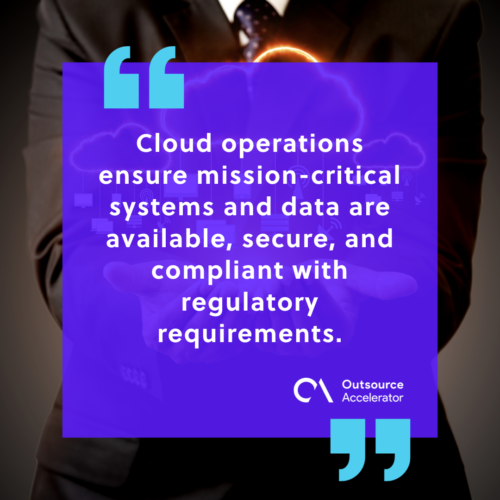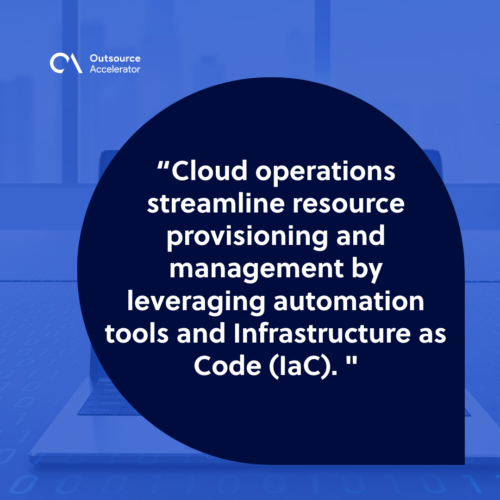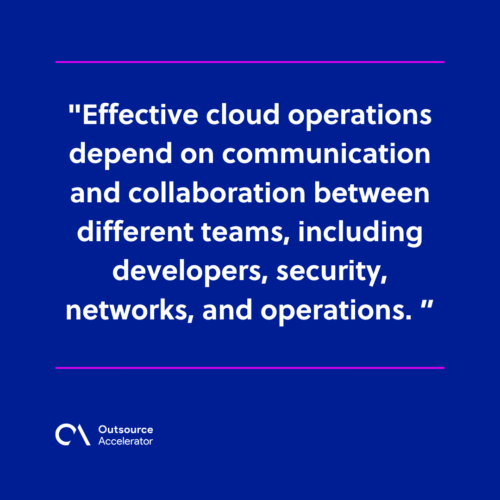What are cloud operations?

Cloud operations have become a cornerstone of modern business operations, transforming how organizations manage and maintain their cloud infrastructure.
Cloud operations have revolutionized how organizations function in the digital realm. This practice aids in provisioning virtual servers, orchestrating intricate applications, and managing vast data troves.
This article delves into the fascinating world of cloud operations, exploring its significance, functions, objectives, and the benefits it can bring. If you’re just starting to explore the possibilities of the cloud, let this piece be a helpful guide.
Cloud operations defined
Cloud operations, often called CloudOps, is the discipline of managing an organization’s cloud infrastructure and resources. It encompasses all practices, processes, and tools involved in cloud maintenance.
Cloud operations involve tasks such as monitoring, provisioning, and configuring cloud resources, applications, databases, and servers.
Cloud operations ensure mission-critical systems and data are available, secure, and compliant with regulatory requirements. The overall goal is to deliver a consistent cloud service to businesses.
Companies like Itransition assist their clients in making the shift to the cloud to improve resiliency and scale up operations.

Cloud operations vs. DevOps
Cloud operations and DevOps (which combine the words “development” and “operations”) are related but distinct concepts in IT and software development. They actually focus on different aspects of the technology landscape.
As previously defined, cloud operations primarily manage and optimize the cloud infrastructure that supports software development and deployment. Cloud operations teams focus on enhancing cloud infrastructure for:
- Scalability
- Security
- Cost-effectiveness
DevOps is a broader approach that focuses on the collaboration and integration of development and IT operations teams. It aims to streamline the development process, enabling faster software delivery.
DevOps encourages a cultural shift, fostering better communication, cooperation, and shared responsibility among IT teams. Its goal is to achieve continuous integration and continuous delivery (CI/CD).
Cloud operations and DevOps can complement each other, with CloudOps being a subset of the broader DevOps framework when applied in a cloud environment.
Integrating cloud operations practices into a DevOps approach can help businesses achieve a more streamlined and efficient cloud-based IT ecosystem.
Functions and objectives of cloud operations
Cloud operations encompass a range of functions that collectively ensure the optimal performance and security of cloud-based systems and applications.
Here are the primary ones:
- Resource provisioning and configuration – Cloud operations procure and manage infrastructure resources like virtual servers, storage, network components, and databases to build and deploy applications.
- Monitoring and performance management – Cloud operations closely monitor the cloud environment to identify potential issues before they impact users.
- Building secure and compliant solutions – Maintaining data security and compliance with industry regulations is a critical objective of cloud operations. This includes adhering to standards like GDPR.
- Continuous infrastructure optimization – This practice continuously optimizes infrastructure to align with the organization’s needs and performance standards.
- Incident response and disaster recovery – It ensures business continuity by managing disaster recovery plans that respond quickly to disruptions.
- Automation and orchestration – Cloud operations streamline resource provisioning and management by leveraging automation tools and Infrastructure as Code (IaC).
- User support and training – Cloud operations provide support and training to end-users, ensuring they’re well-equipped to use the service effectively.

Benefits of cloud operations
Cloud operations offer several benefits to organizations of all sizes:
Cost savings
Effective cloud operations are synonymous with cost savings. Businesses can avoid the upfront costs of purchasing and maintaining physical hardware by leveraging cloud resources.
They can also benefit from economies of scale, paying only for the resources they use.
Scalability and flexibility
Cloud operations allow companies to scale resources as needed. This flexibility allows them to be agile to adapt to changing demands, accommodate traffic spikes, and grow without the limitations of traditional infrastructure.
Enhanced security
Cloud operations teams focus on implementing robust security measures to protect data. Loud service providers often have extensive security measures in place, including:
- Regular security updates
- Data encryption
- Access controls
Improved reliability and availability
Cloud operations teams strive to ensure high availability and reliability. The cloud infrastructure is designed to be distributed across multiple data centers, reducing the risk of service disruptions.
Cloud operations also involve monitoring systems to identify and resolve issues promptly.
Global accessibility
Cloud operations enable organizations to provide global accessibility to their services. It allows users from various locations to access resources easily.
Risks of cloud operations
While cloud operations offer numerous benefits, there are also potential risks that can arise. Understanding them is the first step in mitigating them effectively.
Here are some of the common risks associated with cloud operations:
Service reliability
Dependence on a third-party provider means that organizations have less control over the reliability of their infrastructure.
Despite the high availability offered by cloud service providers, downtime can still occur due to various factors, such as cyberattacks. It’s crucial to have contingency plans or disaster recovery strategies in place.
Vendor lock-in
Switching between cloud providers or moving data and applications back to an on-premises environment can be challenging and costly. Organizations should carefully consider vendor lock-in risks and assess the portability of their applications.
Lack of control and oversight
Cloud operations involve delegating infrastructure management to a third party. This can lead to a loss of direct control and oversight over the underlying infrastructure.
Companies should establish clear communication channels and ensure they have access to necessary monitoring tools and reports.
Data loss
Organizations may encounter challenges in data migration to the cloud, which can lead to data loss or corruption. It’s important to ensure proper backup and recovery mechanisms are in place.
Best practices of cloud operation
Here are some recommended best practices for cloud operations:
- Implement robust cloud governance. This includes policies, procedures, and standards for managing cloud resources.
- Aim for high levels of automation. Prioritize automation wherever possible to reduce manual tasks, minimize errors, and accelerate resource deployment.
- Promote collaboration. Effective cloud operations depend on communication and collaboration between different teams, including developers, security, networks, and operations.
- Engage in resource tagging. Use resource tagging to categorize and label cloud resources, making managing different teams and projects easier.
- Document. Maintain thorough documentation of cloud configurations, processes, and policies.
- Audit regularly. Conduct regular audits to identify vulnerabilities or deviations.
- Perform efficient change management. Establish clear change management processes to track and document changes made to cloud resources.
By adopting these best practices, cloud operations teams can ensure success in their initiatives and help companies stay competitive.

Getting started with cloud operations
Getting started with cloud operations can be a daunting proposition for many organizations.
You can begin harnessing the cloud’s full potential by understanding this guide and the best practices. Your cloud operations campaign may start small, but the benefits will become increasingly apparent as your organization grows and evolves.
The cloud awaits, and your journey begins here.







 Independent
Independent




